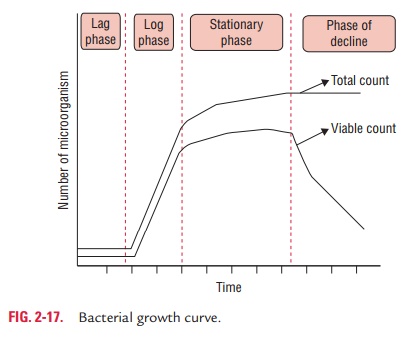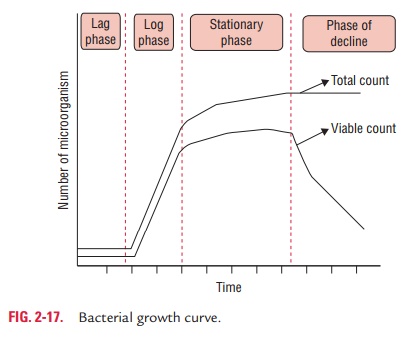Chapter: Microbiology and Immunology: Morphology and Physiology of Bacteria
Bacterial Growth Curve

Bacterial Growth Curve
When a broth culture is inoculated with a small bacterial inoculum, the population size of the bacteria increases showing a clas-sical pattern. The bacterial growth curve shows the following four distinct phases (Fig. 2-17):
1. Lag phase: After a liquid culture broth is inoculated, themultiplication of bacteria does not start immediately. It takes some time to multiply. The time between inoculation and beginning of multiplication is known as lag phase. In this phase, the inoculated bacteria become acclimatized to the environment, switch on various enzymes, and adjust to the environmental temperature and atmospheric conditions. During this phase, there is an increase in size of bacteria but no appreciable increase in number of bacterial cells. The cells are active metabolically. The duration of the lag phase varies with the bacterial species, nature of culture medium, incubation temperature, etc. It may vary from 1 hour to several days.
2. Log phase: This phase is characterized by rapid exponentialcell growth (i.e., 1 to 2 to 4 to 8 and so on). The bacterial

population doubles during every generation. They multiply at their maximum rate. The bacterial cells are small and uniformly stained. The microbes are sensitive to adverse conditions, such as antibiotics and other antimicrobial agents.
3. Stationary phase: After log phase, the bacterial growth almoststops completely due to lack of essential nutrients, lack of water oxygen, change in pH of the medium, etc. and accumulation of their own toxic metabolic wastes. Death rate of bacteria exceeds the rate of replication of bacteria. Endospores start forming dur-ing this stage. Bacteria become Gram variable and show irregular staining. Many bacteria start producing exotoxins.
4. Decline phase: During this phase, the bacterial populationdeclines due to death of cells. The decline phase starts due to (a) accumulation of toxic products and autolytic enzymes and (b) exhaustion of nutrients. Involution forms are common in this stage. Growth rate during different phases of bacterial growth curve is summarized in Table 2-5.

The continuous culture is a method of culture useful for industrial and research purpose. This is achieved by using a special device for replenishing nutrients and removing bacte-rial population continuously so that bacteria growth is not inhibited due to lack of nutrients or due to accumulation of toxic bacterial metabolites.
Related Topics